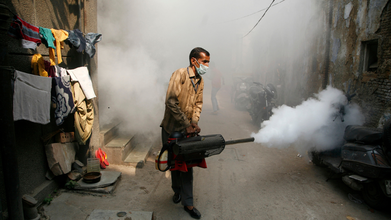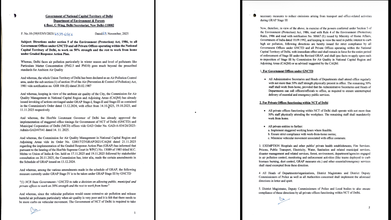- Health Conditions A-Z
- Health & Wellness
- Nutrition
- Fitness
- Health News
- Ayurveda
- Videos
- Medicine A-Z
- Parenting
A Fast-Spreading Flu Variant Is Circulating In The US: Symptoms To Watch For

Credits: Canva
A newly mutated version of the familiar flu virus, Influenza H3N2, known as subclade K, is moving quickly across the northern hemisphere. This rise has raised concerns that the United States may be facing a tougher flu season. This specific offshoot of influenza has become the leading strain in several countries, including the US, Japan, the UK and Canada.
In the Southern Hemisphere, H1N1 led most of the flu activity this year, and H3N2 subclade K only began to spread near the end. Early figures from the UK and Japan show that about 90 percent of flu samples were linked to H3N2 subclade K, according to a report from the University of Minnesota. With a fresh variant circulating and fewer Americans choosing to get vaccinated, the coming months could be quite challenging.
Where Has The H3N2 Subclade K Strain Been Detected?
The European Centre for Disease Prevention and Control reports that this strain has appeared across all continents and makes up roughly one third of all A (H3N2) sequences submitted to the Global Initiative on Sharing All Influenza Data between May and November 2025 worldwide, and nearly half in the European Union. The agency notes that clear data on how well the current vaccine performs in real-world conditions remains limited. Even so, existing vaccines are still expected to help protect against serious illness.
The possibility of a flu season led mainly by H3N2 subclade K is considered moderate, based on the agency’s assessment. The threat is higher for people more likely to develop severe outcomes, including adults over 65, individuals with metabolic, lung, heart, neuromuscular or other long-term medical conditions, pregnant people and those with weakened immune systems.
H3N2 Subclade K Strain: Symptoms To Watch For
The symptoms linked to H3N2 mirror those seen with most influenza viruses and include:
- Fever
- Cough
- Runny nose
- Fatigue
- Muscle aches and chills
This strain may, however, push fevers higher and increase the chances of complications.
Will the New Flu Strain Make for a More Severe Flu Season?
It remains unclear how flu activity will evolve in the United States, and specialists say delays in reliable information have made it trickier to monitor patterns. During the 44-day government shutdown, the CDC paused all updates on respiratory illness. In the most recent “FluView” report for the week ending Nov. 15, national flu activity stayed low, though numbers are climbing, particularly in children. Test positivity and hospital admissions are also going up.
What To Know About The Flu Vaccine?
The CDC advises that everyone aged 6 months and older, with very few exceptions, should get their flu shot.
Still, despite this guidance, fewer people seem to be getting vaccinated each year. CDC figures show that flu vaccine distribution has steadily fallen since the 2021–22 season.
Is the Flu Shot Effective Against the New Strain?
Scientists select the strains for each year’s vaccine based on the viruses circulating globally early in the year, Hopkins explains. The 2025–2026 vaccine includes H1N1, H3N2 and influenza B.
Because the mutated subclade K appeared too late in the cycle, researchers could not adjust this season’s formula. It is not an exact match for the chosen H3N2 strain, but experts stress that the vaccine will still provide valuable protection during the season.
A flu shot does not always stop infection, but it does lower the chances of developing serious illness, needing hospital care or facing life-threatening complications. “The goal of vaccines is to reduce the severity of illness, and reduce the disease impact on our population,” Hopkins says.
This year’s vaccine is also expected to be a strong fit for the H1N1 and influenza B strains that are circulating, Hopkins adds. “You’ll get the protection against two other strains of flu, even if H3N2 isn’t optimal,” Pekosz notes.
As flu activity intensifies, getting vaccinated remains one of the simplest ways to build protection, even against the mutated strain, as doctors continue to underline.
Neuralink: Can Elon Musk’s Brain Chip Help Reverse Paralysis In The Future?

Credits: Canva
The Neuralink chip is a piece of technology that’s hoped will one day allow people to operate devices like phones and computers using their thoughts. Its creator, tech mogul Elon Musk, describes it as a “Fitbit in your skull with tiny wires.” Elon Musk's brain implant company Neuralink said recently that 12 people worldwide have received its chips. The device is meant to have several applications, from restoring motor functionality within people to enabling a brain-computer interface. The question now is whether it will be able to reverse paralysis in the future or not.
Neuralink: What Is Neuralink, And What Does It Do?
Neuralink is a neurotechnology company Musk set up in 2016. The device is roughly the size of a coin and is implanted into the skull, with hair-thin threads placed inside specific parts of the brain to form a working brain-computer interface.
The implant records brain signals and transfers them to an external device, such as a smartphone, through Bluetooth. Its first product, Telepathy, is designed to let a person operate their phone or computer through intention alone. By placing the chip in regions that manage movement, Neuralink believes it could help people living with neurological conditions. Musk has said that early users would likely be people who cannot use their limbs.
Neuralink: What Testing Has Neuralink Carried Out In The Past?
As per Reuters, the company has run trials using monkeys and pigs. Demonstrations have featured monkeys moving a cursor or playing simple on-screen games using the implant. Neuralink maintains that no monkey died because of the device itself, though reports have circulated describing complications in some animals, including paralysis, seizures and swelling in the brain.
Neuralink: Can Neuralink Cure Paralysis?
The human brain contains millions of neurons responsible for movement, emotion and thought. These neurons send electrical signals down pathways that run from the brain to the rest of the body. If a person tries to stand up, the brain sends electrical instructions to the legs, and the reaction is instant. Paralysis develops when pathways in the spinal cord are damaged or blocked, according to the description on Neuralink’s website.
Because the Neuralink implant reads the brain’s signals, it can forward those signals to the limbs even when the spinal cord no longer relays them. This would require one implant in the brain and another placed below the injured area of the spinal cord. With steady training, a person could regain movement, raising the possibility that Neuralink may one day help restore mobility.
Neuralink Ethical Concerns
Experts have questioned the company’s experiments on animals and the general risks linked to brain operations, which can include seizures or bleeding. They have also pointed to worries about data privacy and long-term surveillance, since there is limited detail on how much control users will have over their neural information.
Earlier this year, the US Department of Transportation fined the company for failing to register as a carrier of hazardous biological material, including implants removed from primates, according to agency records reviewed by Reuters.
Neuralink Is FDA Approved
In late May 2023, the FDA granted Neuralink permission to start human testing. The company said on Twitter that the approval marked the beginning of its first clinical study in people, calling it a vital step toward making the technology accessible in the future.
Neuralink has continued to share updates, and in July 2025, it announced that it had completed two brain-implant procedures on the same day. Both individuals are said to be recovering well. Musk responded soon after, expressing confidence in what the technology might achieve in the coming years.
Delhi Sees Highest Malaria Cases in November, Reports a Fourfold Increase

Credits: iStock
In November, Delhi reported 67 malaria case, the highest November tally in four years. However, dengue cases have declined when compared to the same month's data from previous four years. The data is released by the Municipal Corporation of Delhi (MCD).
As per the MCD data, in November 2025, Delhi reported 67 malaria cases, whereas in 2024, it was 57; in 2023, it was 26; in 2022, the number of cases were 36; and in 2021, only 7 cases were recorded.
As for the year 2025, so far 690 cases have reported, which is slightly lower than 744 cases in 2024. However, the number is higher than 369 cases recorded in 2023. The silver lining is that no malaria-related deaths have been reported so far this year. As per the data, malaria cases have gone up in the capital since August. 203 cases were recorded in September, 252 in October, and 67 so far cases in November.
The highest numbers of cases have come from West, South and Civil Line zones of Delhi.
Among other mosquito-borne diseases, chikungunya cases have also seen a drop this month, as only 23 cases were reported so far in November. This number is lower than the 75 cases recorded in November 2024, however is higher than the 15 cases recorded in November 2023, 4 in 2022, and 8 in 2021.
What Is Malaria?
Malaria is a life-threatening disease caused by Plasmodium parasites that are transmitted through the bites of infected Anopheles mosquitoes. Common symptoms include high fever, chills, headache, nausea, vomiting, muscle pain, and fatigue. In some cases, especially when untreated, malaria can cause severe complications such as organ failure, difficulty breathing, or even death. The symptoms typically appear 10 to 15 days after being bitten and can resemble those of the flu, making early diagnosis and treatment crucial.
Are There any Ways For You To Identify Malaria?
Malaria is a life-threatening disease spread to humans by some types of mosquitoes. It is mostly found in tropical countries and is preventable and curable. The infection is caused by a parasite and does not spread from person to person. Symptoms can be mild or life-threatening.
According to the World Health Organization (WHO), mild symptoms include fever, chills and headache. Severe symptoms include fatigue, confusion, seizures, and difficulty breathing. Infants, children under 5 years, pregnant women and girls, travellers and people with HIV or AIDS are at higher risk of severe infection.
There is empirical evidence that it can also be transmitted through blood transfusion and contaminated needles. Transfusion-transmitted malaria (TTM) occurs when an uninfected person receives blood from a donor who is infected with malaria parasites. While malaria transmission through transfusion is rare, especially in non-endemic areas, it remains a significant concern in certain regions. According to a systematic review of studies conducted by National Library of Medicine, Plasmodium parasites were shown to survive in whole blood and plasma when stored at 4°C for up to 18 days, and detectable parasites can present even up to 28 days when frozen, although with diminished infectivity.
Common Symptoms Of Malaria
- extreme tiredness and fatigue
- impaired consciousness
- multiple convulsions
- difficulty breathing
- dark or bloody urine
- jaundice (yellowing of the eyes and skin)
- abnormal bleeding
As Toxic Air Chokes Delhi, Government Asks Offices To Work At 50% Strength

People protest at India gate demanding clean air to breathe (PTI)
Amid the continuously worsening air pollution and air quality levels in Delhi, the government has implemented a work-from-home measures under the Graded Response Action Plan (GRAP).
As per the notice by the Government of National Capital Territory of Delhi and Department of Environment & Forest, all government offices under the GNCTD and private offices operating within Delhi must now function at 50 percent staff strength, with remaining employees required to work from home.
Administrative Secretaries and Heads of Departments may only call essential staff when necessary. However, the overall attendance cannot exceed the 50 percent limit. Private offices have also been instructed to minimize vehicular movement, adopt staggered working hours, and ensure strict adherence to work-from-home protocols to reduce emissions tied to daily commuting.
Read: Living In Delhi's Toxic Air Is A 'Medical Emergency', According AIIMS Doctors
Which Offices Are Not Working From Home?

Essential services, however, are exempt from these restrictions. Hospitals, health facilities, fire services, public transport, water and sanitation departments, disaster management agencies, electricity services, and teams involved in pollution control and emergency duties will continue operating normally.
District Magistrates, Deputy Commissioners of Police and local bodies have been directed to ensure strict compliance across all private offices in Delhi. The restrictions take effect immediately and will remain in force for the full duration of GRAP Stage III, or longer if recommended by the Commission for Air Quality Management (CAQM).
Delhi AQI Today
On Tuesday morning, as of 7:30 am, Delhi woke up to 'Hazardous' air with the AQI as per the aqi.in, recorded at 426. The AQI in Delhi is showing 1.7 times higher than India's average AQI.
The particulate matters have long exceeded the safe limits stated by the World Health Organization (WHO). As of today, the PM10 level is 388 µg/m³, which is 8.6 times above the recommended WHO guidelines. Whereas PM2.5 is at 288 µg/m³, which is 19.2 times the WHO guidelines.
What Does The Doctor Say?
Dr Nikhil Modi, a senior consultant, Respiratory Critical Care and Sleep Medicine at Indraprastha Apollo Hospitals in one of his previous video had said that the pollution is an "ever-growing menace". However, he suggests, one can take simple steps to protected against that.
Like all doctors he too suggested to not go out when the pollution levels are at its peak. "You may go out only if it is very necessary, but wear a mask." As per a 2023 study by an air filter brand, Delhi's air pollution peaked at 9AM and gradually improved as the day progressed. On an average, Delhi sees roughly as half as much PM2.5 by 5PM. The doctor also draws attention on the importance of maintaining a good and healthy diet, especially lots of fruits and vegetables, which are rich in antioxidants.
Health Impact Of Air Pollution Beyond The Lungs
A report by the University of Chicago revealed that air pollution is reducing the life expectancy of Delhi residents by 7.8 years. As per a US-based NGO report by the Health Effects Institute, there has been 30 to 50% increase in lung cancer rates associated with pollutants. A recent 2024 study also revealed that air pollution is not just linked to lung cancer but it can also cause head and neck cancer.
Tata Memorial Hospital published a study in July 2024 that revealed most people who had lung cancer in India never smoked.
"Head and neck cancer is a harder link to show, and it has a much lower occurrence than lung cancers, but since they also occur as a result of smoking, similar to lung cancers, we wanted to explore any connections," said John Cramer, the neck cancer study's lead researcher. "Presumably, the link to head and neck cancer comes from what we breathe to that material affecting the lining in the head and neck. We see a lot of occurrences of where carcinogens touch or pool in the body to where cancers can occur," he explained.
© 2024 Bennett, Coleman & Company Limited

